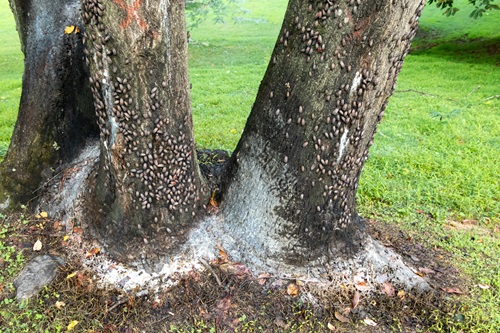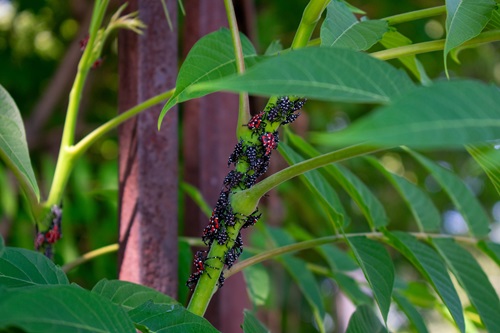
Beautiful but an eco-terrorist: The invasive spotted lantern fly is disrupting sports as well as overall tourism.
A few years ago, it was the cicadas. Every year, mosquitos are a bother. This year (and perhaps in years to come), the spotted lantern fly, an invasive pest, is disrupting tourism, including sports tourism.
Case in point: According to Wisconsin radio station WTMJ, a home game for the Pittsburgh Pirates was upstaged by the bugs, with people paying far more attention to the insects than they were to the on field action against the Brewers.
“It’s been quite a topic for everyone in the Brewers clubhouse,” radio play-by-play broadcaster Lane Grindle said during the broadcast Tuesday night. “There are everywhere in this city. You walk and hear crunches because they are all over the sidewalks. The hotels have people shop-vacuuming the sidewalks.”
A past MiLB promotion offered T-shirts, encouraging the extermination of the bug. And the insects have made their presence known in elite tennis facilities as well. Oh, and on park pickleball courts.

The one-inch-long spotted lantern fly (known as SLF in the entomology circles), while aesthetically beautiful and unable to bite, sting or spit bug juice, are actually hardcore eco-terrorists, and nowhere is it more evident than in the tourism and hospitality sector. Agritourism, a vital and growing sector of that market, can also suffer.
“The SLF has the potential to damage multiple agricultural crops,” said a representative of the Department of Agriculture and Markets in New York. “SLF is a pest of apples, grapes, hops, maple, walnut and others. As part of its damage to crops, SLF could negatively impact agritourism industries/activities in New York State including wine tasting, apple picking and others.”
Want a number? Here’s one.
“The estimated total economic impact of invasive insects in the United States exceeds $70 billion per year, and if not contained, SLF could have an impact to New York State of at least $300 million annually, mainly to the grape and wine industry, which ranks third in the country in production.”
The SLF additionally “has the potential to significantly hinder quality of life and recreational activities.”
Multiple states have reported infestation, and so has Canada.
One of the (we’re sorry for the editorialization here but absolutely disgusting) aspects of SLF is its excretion of a sugary substance known as honeydew. Honeydew attracts swarms of other insects, including ants, wasps and bees, making it a hazard to those with sports events in the area. Honeydew is also readily colonized by black, sooty mold which can cover the leaves of plants and inhibit photosynthesis.
Oh, and one more thing: SLF are not slow-moving, meaning that all the best efforts of people to stomp, swat or slap at them are often in vain. Bug-zapping lights are ineffective since SLF are not a nocturnal species (and not attracted to light), and glue boards and sticky strips catch birds. A small wasp may be the answer but cultivating them is moving far too slowly to be effective. (By the way, SLF are toxic to birds and they won’t eat them.) With more attention being paid to beneficial pollinators like bees, hummingbird moths, butterflies and hummingbirds, homeowners (and venue operators) are hesitant to use pesticides (although they are effective). But in the meantime, millions of SLF eggs are being laid, and will last through winter, only to emerge next spring.
Click here to see the lifecycle of the SLF.
According to the U.S. Fish & Wildlife Service, the SLF is native to southern China, Vietnam, and Taiwan, but began to spread in the early 2000s, first to South Korea and Japan, and then to the United States. Like many other invasive species, it was introduced to new turf accidentally through imported goods. Cars and trains move from city to city and state to state, often unwittingly carrying SLF or their eggs.

“They’re very good hitchhikers,” George Hamilton, department chair of entomology at Rutgers University, told USA TODAY. “Most people don’t even know they’ve got them until the adult form comes out.”
They’re so good at it, in fact, that tailgate parties have become the ideal place for entomologists to hunt for SLF and egg masses on out-of-state-licensed cars.
That means sports tourism is squarely in the crosshairs of scientists who want to keep the bugs from spreading.
Tourism (which sadly is partially responsible for moving the bugs from place to place) has risen to the challenge of killing the bugs. Some states have events like SLF pub craws, in which participants (armed with “kill cards” to track their effectiveness) need to swat bugs in order to earn drinks. Hikers and trail runners are asked to scrape egg masses off trees, and some areas encourage people to “adopt a spot” and keep it free of SFL, their eggs and nymphs.
Traps (sold online) have largely been reviewed as ineffective but that hasn’t stopped people from trying, including creating anti-SLF devices made out of soccer cones.
Oh, and just in case you thought SLF was some kind of a fringe phenom, we can assure you that they’ve made their way into pop culture. As an insult, no less: In one instance, pickleball players were being called “the spotted lantern flies of the sports world.”

